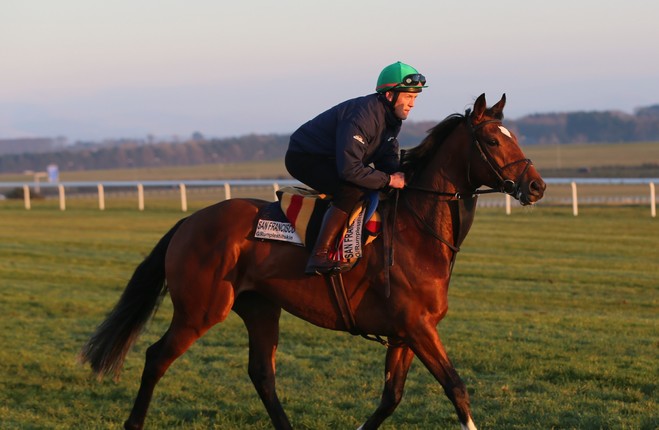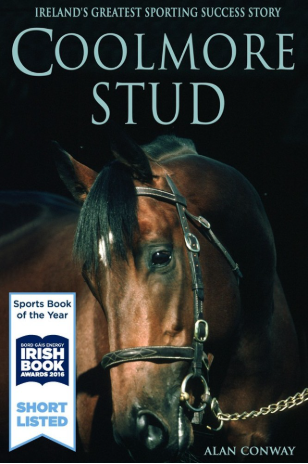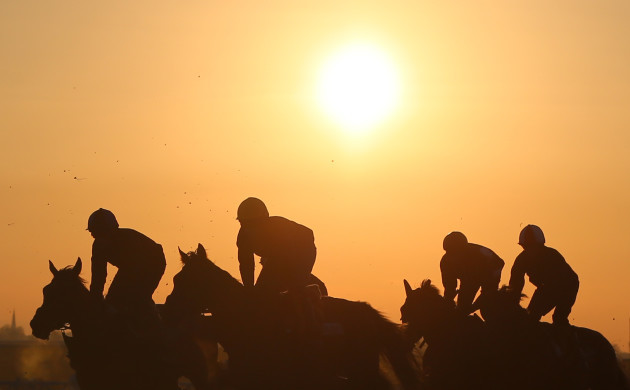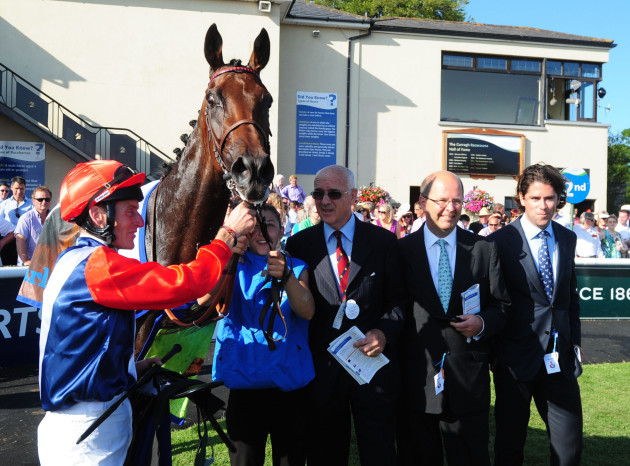THE FOLLOWING PASSAGE is an extract from ‘Coolmore Stud: Ireland’s Greatest Sporting Success Story’.
As Galileo is brushed by his devoted groom, a small but select group of people is waiting. Waiting is not something the head of this particular party is used to, but sometimes even royalty must do it. It’s 2011 and HRH Queen Elizabeth II is at the ‘Home of Champions’ waiting for the king of the stallion world, Galileo.
Here, it is Galileo who is treated like royalty. It is a measure of the esteem iwhich Coolmore Stud is held that when Queen Elizabeth arrived in Ireland for her historic visit in 2011, one of the places on her wish list was the stud farm owned by John Magnier, which has been developed into the finest example of equine entrepreneurship and excellence Ireland has ever seen.
The queen’s trip healed many wounds from the past, both from an Irish and English perspective, but it was her trip to County Tipperary to see the likes of Galileo at stud that showed the standing of Coolmore outside the sporting world. The fact that the queen wanted her trip to be a private affair emphasises the point further.
Throughout the world, the name Coolmore is synonymous with excellence. It is an Irish success story, one of the greatest to come out of Ireland since the foundation of the State. Its impact has been immense. From the farm to the winner’s enclosure, excellence is not just a word but a lifestyle that runs through Coolmore, from the people mucking out the stalls to the men and women purchasing multi-million-euro foals and yearlings with the dream that they will retire to Coolmore and become the next generation of super stallions or blue-hen broodmares.
Excellence is evident from the moment you pass the statue of Be My Guest at Coolmore’s head office in County Tipperary. When you walk past the bridles of champion sires such as Danehill, Sadler’s Wells and Galileo, and step into the reception area, where you are greeted by a friendly face behind the horseshoe desk, you immediately feel surrounded by greatness. The old cliché that it’s something that money cannot buy certainly rings true here.
Before 1975, in the period of Irish horse racing known as bc (before Coolmore), Irish racing and Ireland as a nation were searching for an identity, searching for who we were both as a people and as a country. The fuel crisis of 1973, along with conflict in Northern Ireland, left Ireland wandering around in the dark looking for a door that would let in some light and allow us to believe that there could be a brighter future.
In horse racing, people were also looking for that ray of light. As Ireland stumbled from one crisis to the next, the best horses of the 1950s and 1960s were all exported to England and further afield, so the chances of finding another Arkle, widely considered the greatest National Hunt horse in racing history, were slim.
Irish racing itself had been plodding along for many years at the same pace until 1962, when the Irish Derby was turned into a sweepstake by Joe McGrath. A stroke of a pen turned the 1 mile 4 furlong Group 1 into the richest race in Europe. It was a masterstroke and led to the Irish Derby becoming one of the most hotly contested races anywhere in the world, with a prize fund of £60,000.
In the 1962 race, twenty-four horses and riders went to post, led by Epsom hero Larkspur, who was looking to become the first horse since 1907 to complete the English/Irish Derby double. The crowd, which some say was between 40,000 and 70,000 strong, witnessed a thrilling race that was won by Tambourine and Etienne Pollet, trainer of the immortal Sea-Bird.
This new-look Irish Derby was a big step in the right direction for Irish racing, but it wasn’t until Vincent O’Brien began to source Northern Dancer-bred horses from the big sales in America that the tide really began to turn.
Not only did Vincent and his partners bring back to Ireland some world-class talent, including the great Nijinsky, they also brought their wealthy owners and encouraged them to spend time and money in Ireland while their horses were winning on the racetrack.
After the success of Nijinsky, who in 1970 won the Epsom and Irish Derbies, the 2000 Guineas at Newmarket and the St Leger, the trickle soon turned into a flood, and suddenly the best horses in the world and some of the most powerful owners in the world were setting up operations in Ireland. The Syndicate of Vincent O’Brien, John Magnier and Robert Sangster turned Irish racing from a cottage industry into the number-one source of equine and human talent in the racing world.
With the likes of The Minstrel winning the Epsom and Irish Derbies, along with the King George at Ascot, Irish racing’s reputation began to grow, and suddenly people were looking to Ireland, rather than America or England, as a place where they could develop their racing interests. Although The Minstrel was sold to America as a stallion, every champion that Coolmore subsequently had was retired to stud at its base in Tipperary, and soon the farm grew into the powerhouse it is today.
The decisions made by a small group of people had a profound and lasting effect on Irish racing and on Ireland as a country. The success that Coolmore enjoyed not only brought financial rewards but also boosted Ireland’s confidence that it could not only compete on the world stage but also win.
The names Vincent O’Brien and Coolmore were suddenly in bright lights. The sight of the Irish flag being hoisted high at Epsom, Longchamp, Washington or Melbourne became familiar, as Irish horses and trainers targeted foreign prizes that were previously a distant dream.
As Coolmore grew and developed, so too did the class of horse bred there. Thanks to leading sires Sadler’s Wells and Danehill, some of the most renowned horses in racing were gifted to the world. Think In The Wings, High Chaparral, Montjeu and Galileo, who were all sired by Sadler’s Wells, and Rock Of Gibraltar, Danehill Dancer, Duke Of Marmalade and Dylan Thomas, who all had Danehill as their sire. All these horses touched the lives not just of the people at Coolmore, but also of the wider racing public, many of whom developed a love of horses thanks to the stud.
Many people would argue with the assertion that Coolmore is the dominant force in the bloodstock industry when it is compared it to the juggernaut that is the Godolphin/Darley operation, spearheaded by Sheikh Mohammed, the ruler of Dubai. Since the 1980s the distinctive red and white colours of Sheikh Mohammed and, in more recent times, the royal-blue silks of his Godolphin operation have been immensely successful, winning many Group/Grade 1s throughout the world. It raised the standard of horses in Europe to such an extent that there was a time when people worried what the horse-racing industry would do if the Arab money dried up, such was the impact it had on British racing.
However, while Godolphin/Darley has enjoyed tremendous success and is, quite rightly, lauded as a wonderful ambassador for its region, Coolmore has built its success over the last fifty years without the enormous financial muscle that Sheikh Mohammed and his associates have had at their disposal. If the Dubai operation wanted a particular horse, it could simply wave its chequebook and that horse would soon be running in its livery. While there is nothing wrong with that, Coolmore simply didn’t have the financial clout to operate that way in the 1980s. Instead it had to develop its own stars through the likes of Sadler’s Wells and Danehill.
An indication of Coolmore’s success in its approach is that in the last few years Godolphin/Darley has changed its modus operandi to echo that of Coolmore and has started to successfully develop its own stallions, headed by the hugely successful Dubawi. He finished runner-up to Galileo in the 2015 sires’ championship.
An example of the stranglehold that Coolmore has enjoyed over the breeding industry came in 2005, when Darley Stud boycotted the purchase of any Coolmore-sired stock auctioned at public sales. It was an extraordinary move and one that many racing insiders couldn’t fathom. With Sadler’s Wells still siring Group 1 horses, and with his three sons Galileo, High Chaparral and Montjeu in the early stages of their stallion careers, it appeared to make little sense for Sheikh Mohammed and his team to pass up the opportunity to own the next great potential champion racehorse. One could almost understand where the Dubai operation was coming from, as Coolmore tended to purchase stock sired by their own stallions and, in the main, didn’t purchase non-Coolmore-sired stock.
However, when the best young stock is sired by Coolmore stallions, could anyone really blame John Magnier and his associates for continuing to purchase stock by Sadler’s Wells, Galileo and others at the bloodstock sales?
Coolmore also played its part in the fall-out with Darley, as for six years it didn’t send any Ballydoyle horses to Dubai’s signature event, the Dubai World Cup, now held in March at the futuristic Meydan Racecourse. This was a big blow, because without any Coolmore horses there was a certain lustre missing from a meeting that prides itself on its international flavour, as was witnessed when the Irish-trained Sole Power landed the Group 1 Dubai Golden Shaheen at the 2015 meeting.
Whatever the reasons, the boycott was damaging for the entire bloodstock industry. Sheikh Mohammed’s Godolphin suffered two years of poor racetrack performances, as its crop of horses at the time was simply not up to standard, while breeders who were taking a Coolmore-sired yearling to the sales knew that their customer base would be cut dramatically while the Sheikh and his supporters boycotted Coolmore progeny.
Eventually, in a nod to the influence Coolmore has in the industry, Sheikh Mohammed bought into the Coolmore bloodlines by purchasing a controlling stake in the 2006 European champion two-year-old colt Teofilo, who was trained by Jim Bolger. This son of Galileo enjoyed an undefeated five-race juvenile campaign before an injury brought an end to his racing career. Teofilo was subsequently retired to Sheikh Mohammed’s Kildangan Stud in County Kildare, where he became a noted stallion, siring the likes of Pleascach, who won the Irish 1000 Guineas and the Yorkshire Oaks for Godolphin and Jim Bolger in 2015.
While nobody would admit it, having access to Coolmore’s bloodlines was just the kick that Godolphin/Darley needed as it looked to re-establish itself among the elite players in flat racing. It is also fair to say that Godolphin came off worse in its ‘feud’ with Coolmore. Because it chose not to purchase young stock sired by Coolmore stallions, it deprived itself of horses able to competeat the highest levels of flat racing for a number of years. It wasn’t the wisest decision the Godolphin/Darley operation ever made.
Coolmore also signalled its intention to develop a more harmonious working relationship with Sheikh Mohammed when in 2011 it sent its Irish Derby and Irish Champion Stakes winner Cape Blanco to contest the $10 million Dubai World Cup, a Grade 1 race run on Meydan’s track. It was a move initiated by Dr Jim Hay, who bought a stake in Cape Blanco along with fellow Irish Derby winner and future Ascot Gold Cup winner Fame And Glory, becoming one of the few people to own a horse in Ballydoyle aside from the Magnier, Tabor and Smith axis.
Speaking at the time to The Guardian, Hay said of the decision to bring Cape Blanco to Dubai:
“You could maybe see this as a move that could bring the two sides together. These squabbles are just part of life, they come, they go. I think, hopefully in the years to come, we’ll see a lot more of the [Irish] folks with top-class horses here, which must be good for Dubai. It should be win, win, win.”
Since 2011 both Coolmore and Godolphin have enjoyed many battles on the racetrack, most memorably when the Godolphin-owned Encke denied the Coolmore-owned Camelot the English Triple Crown when running out a narrow winner of the 2012 St Leger at Doncaster.
The following year, in May 2013, Encke was one of twenty-two Godolphin-owned horses to test positive for anabolic steroids in an out-of-competition test conducted by the British Horseracing Authority (BHA) and was banned from racing for six months.
While Godolphin/Darley continues its quest to once again become the greatest force in world racing, Coolmore seamlessly continues its domination of global racing, both on the racetrack and in the breeding sheds. In 2012, one year after Sadler’s Wells passed away, Coolmore achieved something unique in the world of breeding when its stallions became the champion sires in Europe, America and Australia. Galileo secured the European crown, while Giant’s Causeway and Fastnet Rock became champion sires in America and Australia respectively. It was a tremendous achievement and one that may not be equalled for quite some time.
Coolmore’s importance to Irish sport continues to grow. One wouldn’t need many fingers to calculate the number of Irish entities that command the worldwide respect that Coolmore has enjoyed for the last 50 years. During the breeding season, which begins in early February, Coolmore hosts mares from America, Australia and even Japan, as breeders from all over the world want access to stallions such as Galileo. It is this international reputation that places Coolmore among the most successful and important sporting entities to emerge from Ireland.
When thinking of Irish sporting successes in a worldwide context, many would automatically mention the tremendous success that the Irish rugby team has enjoyed in recent times, or the outstanding achievements by our boxers or athletes over the decades, but few people outside the small world of horse racing would mention Coolmore/Ballydoyle. Yet both Vincent O’Brien and Aidan O’Brien should be held in similarly high regard for their achievements. To have achieved so much, on both a domestic and international stage, in National Hunt and flat racing, and to be so consistent, are the true marks of greatness.
With Aidan O’Brien at the helm, the Coolmore/Ballydoyle operation looks well placed to continue the success it has enjoyed over the last twenty years. One can’t help but feel that its next big goal is to own a Triple Crown winner. Having come so close with Camelot in 2012, when the colt was narrowly beaten in the final leg of the English St Leger, there must be a tremendous desire within the organisation to have the next horse to win the Triple Crown and follow in the hoofprints of the last colt to win it – Nijinsky, in 1970.
I was at the Curragh Racecourse on the day Camelot was defeated in the St Leger. When Aidan O’Brien and his son Joseph, who rode Camelot that day, arrived to contest the Group 1 National Stakes, the crowd clapped them all the way from their helicopter in the middle of the track to the weight room. It was an extraordinary gesture that showed the high regard in which both Coolmore and Ballydoyle are held by many of the Irish racing public.
For the last five decades, Ireland has consistently produced trainers and horses who have shone on the world stage. It is an extraordinary achievement to have that much success over that length of time and one that should be shouted from the rooftops.
Think of the likes of Dermot Weld, who became the first non-Australian to win the Melbourne Cup with Vintage Crop in 1993 and the first Irish trainer to win an American Classic race with Go and Go in the 1990 Belmont Stakes; Jim Bolger, who has won big Group 1 and Grade 1 races throughout the world; and John Oxx, who masterminded the wonderful career of Sea The Stars. However, the successes of Coolmore and Ballydoyle are at the top of this list.
When Australia landed the 2014 Epsom Derby, he gave Aidan O’Brien an unprecedented third triumph in the race following on from Camelot (2012) and Ruler Of The World (2013). It was the first time in the history of that great race that any trainer had saddled the winner for three consecutive years. Even more remarkably, the Coolmore owners were winning the race for the fourth year, as Pour Moi had taken victory for France in 2011.
To have horses good enough to run in four editions of the Derby is an achievement in itself, but to own the winner and for the winners to come from your own stallions, well that is an achievement beyond comparison.
Horse racing is big business in Ireland and Coolmore is at the forefront, driving the industry to ever greater heights. One example of the money generated by the bloodstock industry came in November 2013 when a regally bred daughter of Montjeu came up for auction at a horses-in-training sale at Goffs in County Kildare.
Chicquita, who was trained to win the 2013 Darley Irish Oaks by Alain de Royer-Dupré, was part of Paul Makin’s dispersal of his bloodstock interests. Not only was she a beautiful-looking filly, she had gold-plated Group 1 form on her résumé. As well as winning the Irish Oaks in dramatic style (she veered across the racetrack with her jockey Johnny Murtagh and looked to have thrown the race away on several occasions), the mare had previously finished second to subsequent dual Prix de l’Arc de Triomphe winner Treve in the French Oaks that same summer.
Given her race record and her looks, there was a buzz around the auditorium when she came up for auction. Henry Beeby, CEO of Goffs, led the sale and started the bidding at an eye-watering €3 million. The sale was off and running in spectacular fashion and the bids kept on coming. €3.1 million, €3.2 million, €3.3 million. Eventually there were only two bidders left: a bloodstock agent bidding for Sheikh Fahad Al Thani, one of the biggest and most recent players to come into the elite end of flat racing, and the father-and-son team of Peter and Ross Doyle, who were bidding on behalf of Coolmore.
These two superpowers went toe to toe. €4 million, €4.5 million, €5 million. Both sides refused to give an inch in the battle for this filly. With the tension in the room reaching near breaking point, the bids continued. €5.5 million, €5.6 million, €5.7 million. Then it came – the moment when the Doyle operation and Coolmore finally outbid Sheikh Fahad. A bid of €6 million was made on behalf of Coolmore, and the Sheikh’s bloodstock agent walked away. Coolmore had won the battle and got its filly for a record-breaking price. In that instant Chicquita became the most expensive horse ever sold in Ireland and Coolmore showed, once again, that it was the biggest dog in the bloodstock yard.
It was an amazing purchase and one that illustrated the pulling power that Ireland has as a horse-producing country. This point was expanded upon when Henry Beeby, speaking in the excellent documentary Power in the Blood, said of the sale, ‘It demonstrated that Ireland is top of the tree and is the spiritual home of the thoroughbred. We had two of the biggest superpowers in world racing here at Goffs bidding in an Irish sales ring for an Irish-bred filly. That’s very important.’
Since she had sold for a colossal amount of money, expectations were high that Chicquita would continue her excellent racecourse performances for her new trainer, Aidan O’Brien. Sadly she could never regain the winning thread and she failed to win in four attempts for her new connections, finishing down the field in the 2014 Prix de l’Arc de Triomphe, before ending her racing career with a disappointing fifth place in the Breeders’ Cup Turf at Santa Anita. It will be interesting to see if she will be able to produce a top-class son or daughter during her time as a broodmare.
The strength of the Irish bloodstock industry was again illustrated in September 2015, when history was made. For the first time four yearlings were sold for more than €1 million at Goffs. Prices of €2 million, €1.7 million, €1.2 million and €1.05 million, paid by four separate buyers, set a new record for Goffs as the highest number of million-plus lots in the history of the sale. Henry Beeby said of the record-breaking sale:
“Never before have we sold four seven-figure lots at a Goffs [Orby] yearling sale nor three in a single day, so we are naturally elated to have catalogued this quartet of truly illustrious yearlings. The fact is that a deeper analysis of Orby shows a sale that has grown by 41 per cent in just two years, so we have essentially consolidated those gains, and the sale remains a firm favourite with vendors and purchasers alike whilst, very significantly, we are attracting an increasing number of the very best, as demonstrated by the million-euro lots. This year we have welcomed increased numbers of overseas buyers following a number of international trips and with the assistance of Irish Thoroughbred Marketing.”
The continued success of Coolmore is one of the reasons it deserves to be ranked alongside the famous boxers, athletes, rugby and soccer players who have represented Ireland with such distinction. However, the private nature of the operation means that people outside horse racing may never fully appreciate what a world-class entity Coolmore Stud really is. Simply put, its people are the very best in the world at what they do.
Coolmore is one of the brightest diamonds that Ireland has, and in the age of the bankers and jokers who brought Ireland to its knees, it’s comforting to see people like John Magnier thrive, and know that as a nation Ireland can still shine on the world stage. From little acorns, as the old saying goes, mighty oaks grow, and Coolmore will continue to grow and grow for generations to come.
‘Coolmore Stud: Ireland’s Greatest Sporting Success Story’ by Alan Conway is published by Mercier Press. More info here.




